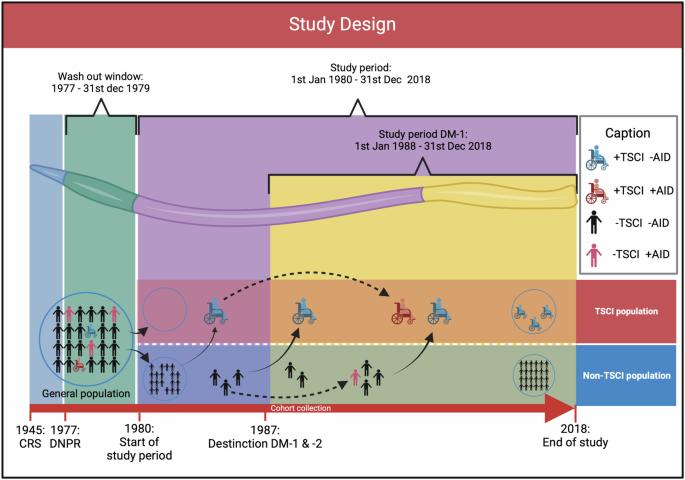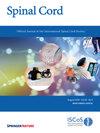Traumatic spinal cord injury and its correlation to risk of autoimmune/-inflammatory disease
IF 2.2
4区 医学
Q3 CLINICAL NEUROLOGY
引用次数: 0
Abstract
Nationwide epidemiological open cohort study. To evaluate whether individuals with traumatic spinal cord injury (TSCI) are more prone to develop autoimmune diseases compared to a general non-TSCI population. Danish public national registries. An open nationwide cohort, including individuals born in Denmark from or alive during 1945-2018 was collected and the study period was 1980-2018. Poissons Log-linear regression estimated the incidence rate ratio (IRR) for developing eight groups of autoimmune diseases. A dose-response relationship based on the cervical/thoracic level of injury was assessed by stratification. The cohort included 3,272 individuals with TSCI and 4.8 million background individuals, accounting for 50,865 and 140 million person-years respectively. The TSCI population had an overall IRR of 1.81 (95% CI, 1.59 to 2.05) of getting any autoimmune disease. Subgroup analysis found positive associations for; a) Other neurologic IRR 5.19 (95% CI, 2.79 to 9.65), b) multiple sclerosis IRR 3.70 (95% CI, 2.54 to 5.40), c) Dermatologic IRR 2.57 (95% CI, 1.86 to 3.55), d) Type 1 diabetes mellitus IRR 2.01 (95% CI, 1.54 to 2.61), e) Systemic 1.92 (95% CI, 1.44 to 2.55), and f) Gastroenterologic IRR 1.42 (95% CI, 1.05 to 1.92). Cervical levels of TSCI showed an IRR of 1.70 (95% CI, 1.43 to 2.02), while thoracic levels had an IRR 1.98 (95% CI, 1.63 to 2.39). TSCI may be an individual risk factor of developing an autoimmune disease. There does not appear to exist a dose-response relationship from the level of injury. None.


创伤性脊髓损伤及其与自身免疫性/炎症性疾病风险的相关性
研究设计全国范围的流行病学开放式队列研究目的评估与一般非创伤性脊髓损伤(TSCI)人群相比,创伤性脊髓损伤(TSCI)患者是否更容易罹患自身免疫性疾病。方法收集全国范围的开放式队列,包括1945-2018年期间在丹麦出生或存活的个体,研究时间为1980-2018年。波松对数线性回归估算了八组自身免疫性疾病的发病率比(IRR)。结果队列中包括 3272 名 TSCI 患者和 480 万名背景人群,分别占 50865 人年和 1.4 亿人年。TSCI人群罹患任何自身免疫性疾病的总体IRR为1.81(95% CI,1.59至2.05)。亚组分析发现:a) 其他神经系统 IRR 5.19(95% CI,2.79 至 9.65),b) 多发性硬化 IRR 3.70(95% CI,2.54 至 5.40),c) 皮肤病 IRR 2.57(95% CI,1.86 至 3.55),d) 1 型糖尿病 IRR 2.01(95% CI,1.54 至 2.61),e) 系统性 1.92(95% CI,1.44 至 2.55),f) 消化系统 IRR 1.42(95% CI,1.05 至 1.92)。颈椎 TSCI 水平的 IRR 为 1.70(95% CI,1.43 至 2.02),而胸椎水平的 IRR 为 1.98(95% CI,1.63 至 2.39)。没有赞助。
本文章由计算机程序翻译,如有差异,请以英文原文为准。
求助全文
约1分钟内获得全文
求助全文
来源期刊

Spinal cord
医学-临床神经学
CiteScore
4.50
自引率
9.10%
发文量
142
审稿时长
2 months
期刊介绍:
Spinal Cord is a specialised, international journal that has been publishing spinal cord related manuscripts since 1963. It appears monthly, online and in print, and accepts contributions on spinal cord anatomy, physiology, management of injury and disease, and the quality of life and life circumstances of people with a spinal cord injury. Spinal Cord is multi-disciplinary and publishes contributions across the entire spectrum of research ranging from basic science to applied clinical research. It focuses on high quality original research, systematic reviews and narrative reviews.
Spinal Cord''s sister journal Spinal Cord Series and Cases: Clinical Management in Spinal Cord Disorders publishes high quality case reports, small case series, pilot and retrospective studies perspectives, Pulse survey articles, Point-couterpoint articles, correspondences and book reviews. It specialises in material that addresses all aspects of life for persons with spinal cord injuries or disorders. For more information, please see the aims and scope of Spinal Cord Series and Cases.
 求助内容:
求助内容: 应助结果提醒方式:
应助结果提醒方式:


